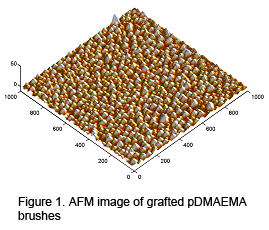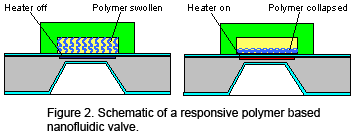| Welcome | People | Research | Presentations | Publications | Facilities | Links |
|---|
|
|
|
|
|
> Stimuli-Responsive Polymers |
Micro- and Nanofluidic Manipulation Using Nanoengineered, Stimuli-Responsive Polymers

![]() We are pursuing the synthesis, characterization and micro/nanofluidic application of surface-grafted polymer nanolayers (1-100 nm)
whose volume and surface wettability exhibit drastic reversible changes (up to a few hundred percent) in response to a relatively
small change in temperature (~10 C). Compared with other responsive polymer systems (e.g., hydrogel microstructures)
that have been used in microfluidics, grafted polymer nanolayers are covalently attached to the substrate and have well-ordered molecular
structure. Therefore, such polymer nanolayers are robust, afford excellent long-term stability, and allow exquisite fine-tuning of surface properties.
Exploiting their stimuli-responsiveness, such polymers will provide an innovative platform for micro/nanofluidic manipulation.
We are pursuing the synthesis, characterization and micro/nanofluidic application of surface-grafted polymer nanolayers (1-100 nm)
whose volume and surface wettability exhibit drastic reversible changes (up to a few hundred percent) in response to a relatively
small change in temperature (~10 C). Compared with other responsive polymer systems (e.g., hydrogel microstructures)
that have been used in microfluidics, grafted polymer nanolayers are covalently attached to the substrate and have well-ordered molecular
structure. Therefore, such polymer nanolayers are robust, afford excellent long-term stability, and allow exquisite fine-tuning of surface properties.
Exploiting their stimuli-responsiveness, such polymers will provide an innovative platform for micro/nanofluidic manipulation.

![]() As a first step, we are exploring brushes of poly(dimethylaminomethyl methacrylate) (pDMAEMA) grafted to silicon, glass, or gold surfaces.
This polymer can be prepared with exquisite control in chain length, uniformity, composition, topology, and a readily adjustable range
(from room temperature to ~55 C) of the lower critical solution temperature (LCST), the critical temperature around which the properties (e.g., volume and wettability)
of the polymer exhibit a drastic change. We have successfully prepared the grafted polymer on silicon surfaces, and are characterizing its static and dynamic response to
temperature changes with atomic force microscopy (AFM) and surface plasmon resonance (SPR) (Figure 1).
As a first step, we are exploring brushes of poly(dimethylaminomethyl methacrylate) (pDMAEMA) grafted to silicon, glass, or gold surfaces.
This polymer can be prepared with exquisite control in chain length, uniformity, composition, topology, and a readily adjustable range
(from room temperature to ~55 C) of the lower critical solution temperature (LCST), the critical temperature around which the properties (e.g., volume and wettability)
of the polymer exhibit a drastic change. We have successfully prepared the grafted polymer on silicon surfaces, and are characterizing its static and dynamic response to
temperature changes with atomic force microscopy (AFM) and surface plasmon resonance (SPR) (Figure 1).
We are pursuing several applications of thermally responsive grafted polymers to micro/nanofluidic manipulation and control. In all these applications, a responsive polymer
nanolayer is grafted on the surface of a silicon chip that is integrated with an array of resistive microheaters. These heaters allow localized heating to effect changes in polymer
properties at desired locations on the chip surface. The first application exploits reversible changes in polymer volumes to enable micro/nanofluidic control devices
(e.g., valves as shown in Figure 2). In the second application, we are exploring the thermally switchable wettability of polymer surfaces to manipulate liquid droplets as small as
femtoliters in volume. Finally, we are investigating chromatographic separations of DNA oligomers from complex solutions on thermally responsive polymer surfaces of a
microchannel, such that separation and recovery of DNA respectively occur on hydrophobic and hydrophilic surfaces that are reversibly switched by a temperature change.
Dr. Tomasz Kowalewski (Chemistry, CMU)
Dr. James Schneider (ChemE, CMU)
Dr. Robert Tilton (ChemE, CMU)
Dr. Lee White (ChemE, CMU)
Dr. Yi-Kuen Lee (ME, HKUST)
Researchers
Yonduck Sung , M.S. Student (ME)
Jared Metter, Undergraduate Student (ME)
Eunice Ng, Undergraduate Student (ECE)
Yongjun (Jay) Zhao, Postdoctoral Scholar (ME)